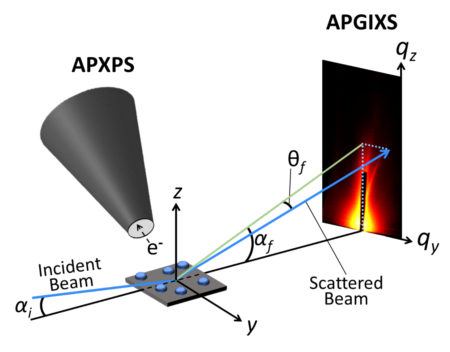 Understanding a surface under reactive conditions requires two different but closely related sets of information: the chemistry and the morphology of the sample. Until recently, these types of information could only be studied in separate experiments.
Understanding a surface under reactive conditions requires two different but closely related sets of information: the chemistry and the morphology of the sample. Until recently, these types of information could only be studied in separate experiments.
“There is a big disconnect if the sample is investigated in two sequential experiments,” said ALS Staff Scientist Slavo Nemsak. And so, he was on a quest to capture a complete picture by using two x-ray techniques simultaneously: ambient-pressure x-ray photoelectron spectroscopy (APXPS) and grazing-incidence x-ray scattering (GIXS).
“They’re wonderfully orthogonal,” Nemsak said. But, combining them in the small footprint typically available at an endstation was not easy. In recognition of Nemsak’s achievement of this feat, the ALS Users’ Executive Committee awarded him the 2023 Klaus Halbach Award for Innovative Instrumentation for “the development of the state-of-the-art combined scattering and spectroscopy setup at ALS Beamline 11.0.2.”
One of the challenges Nemsak had to overcome was that “conventional” x-ray scattering beamlines don’t work at ambient pressures. Nemsak’s former ALS colleague Hendrik Bluhm, who is now a group leader at the Fritz Haber Institut in Germany, explained, “Since the detector requires vacuum conditions, it has to be separated from the reaction gas environment in the sample compartment by a window, which has to have a large size and is thus vulnerable to breaking.” But, the same detector must have a large acceptance angle, with corresponding space requirements. Nemsak resolved the space constraints by using a pivoting manipulator that moves the camera across a quasi-spherical surface. As an active user of the instrument, Bluhm has benefitted firsthand from the advancement. “I am impressed by the dedication and ingenuity that Slavo showed in the design and commissioning of this first-of-a-kind development,” he said.
Not only is the set-up now operational at Beamline 11.0.2, Nemsak’s design has spread to other parts of the world as well. “The establishment of this multimodal instrument had a major impact on the international community,” Bluhm said, pointing to two new dedicated beamlines being established at BESSY-II in Berlin and ALBA in Barcelona. “Both are based on Nemsak’s successful demonstration of the combination of APXPS and GIXS,” he added.
One of the first subjects studied was morphological changes in single crystals under ambient conditions. “That ended up being very challenging because it requires an extremely clean setup that is also capable of ambient-like gas exposures,” Nemsak explained. “So, the background pressure had to be very, very good, just to be able to prepare these atomically flat single crystals and keep them clean for long enough to measure them,” he added. The experiments became even more complex when the researchers exposed these samples to environments like oxygen, carbon monoxide, or humidity.

Next, with a team from Forschungszentrum Jülich, Nemsak looked at the synthesis of nanocatalysts for oxygen evolution reactions. These are nanoparticles of transition metals that precipitate from perovskite oxide thin films under reducing conditions. The new setup allowed the team to study the formation of nano-islands in real time as well as probe them chemically and measure their amount and size.
Other users are already envisioning further uses for the setup at Beamline 11.0.2. Baran Eren from the Weizmann Institute of Science in Israel described a type of investigation that would also benefit from this setup. “Reactive species in bimetallic alloy catalysts can de-alloy/segregate under reaction conditions, altering their surface composition,” he explained. A multimodal investigation would provide a more detailed understanding of the correlation between chemistry, structure, and function in these systems. He also cited another system of interest. “The new endstation will enable studies of polyamide membranes for water purification, which exhibit correlations between water permeability and the presence of nanoscale Turing structures.”
Right now, the endstation at Beamline 11.0.2 is still the prototype that was used to demonstrate that Nemsak’s idea actually works. But he has already begun to upgrade it. “It will have a large x-ray detector capable of covering the required acceptance angle in a single shot, accelerating our experiments tremendously.” He would also like to implement a similar setup at a hard or tender x-ray beamline. “This would provide a higher excitation energy for depth-enhanced photoelectron spectroscopy and a shorter wavelength to look at sub-nanometer objects,” Nemsak said.

Berkeley Lab has committed funding to develop this instrumentation even further. Nemsak is a co-PI on a recently funded Laboratory Directed Research and Development (LDRD) project that will add Raman spectroscopy to his endstation, providing even deeper insights into, for example, phase-change materials.
Nemsak’s endstation has become so indispensable that it may be hard for people to remember a time when the ALS existed with neither the endstation nor its creator. But he has not always been at the ALS. After spending time as a postdoc at UC Davis and the ALS, he worked as a group leader at BESSY-II in Germany before returning to the ALS. The main reason that made him come back? The collaborative spirit at the ALS, in everyone from techs to scientists. “Everyone tries to make the best science happen for our collaborators, our users, and society as a whole,” Nemsak marveled. And, we are all happy to have Nemsak at the ALS.
Klaus Halbach was a senior staff scientist at LBNL who pioneered the development of undulators using permanent magnets, and other innovations in accelerator physics. Even though he retired from LBNL in 1991, he remained active in lab projects and student training until his death in 2000.